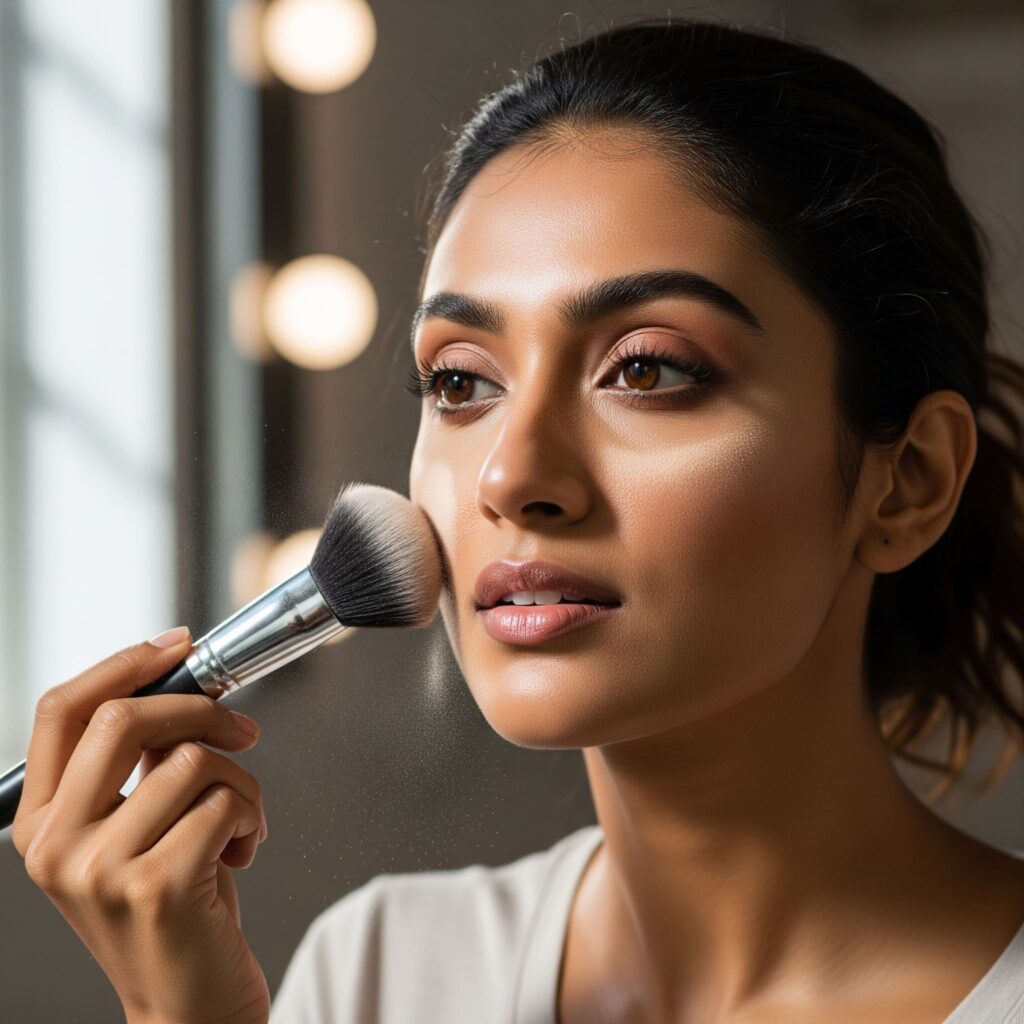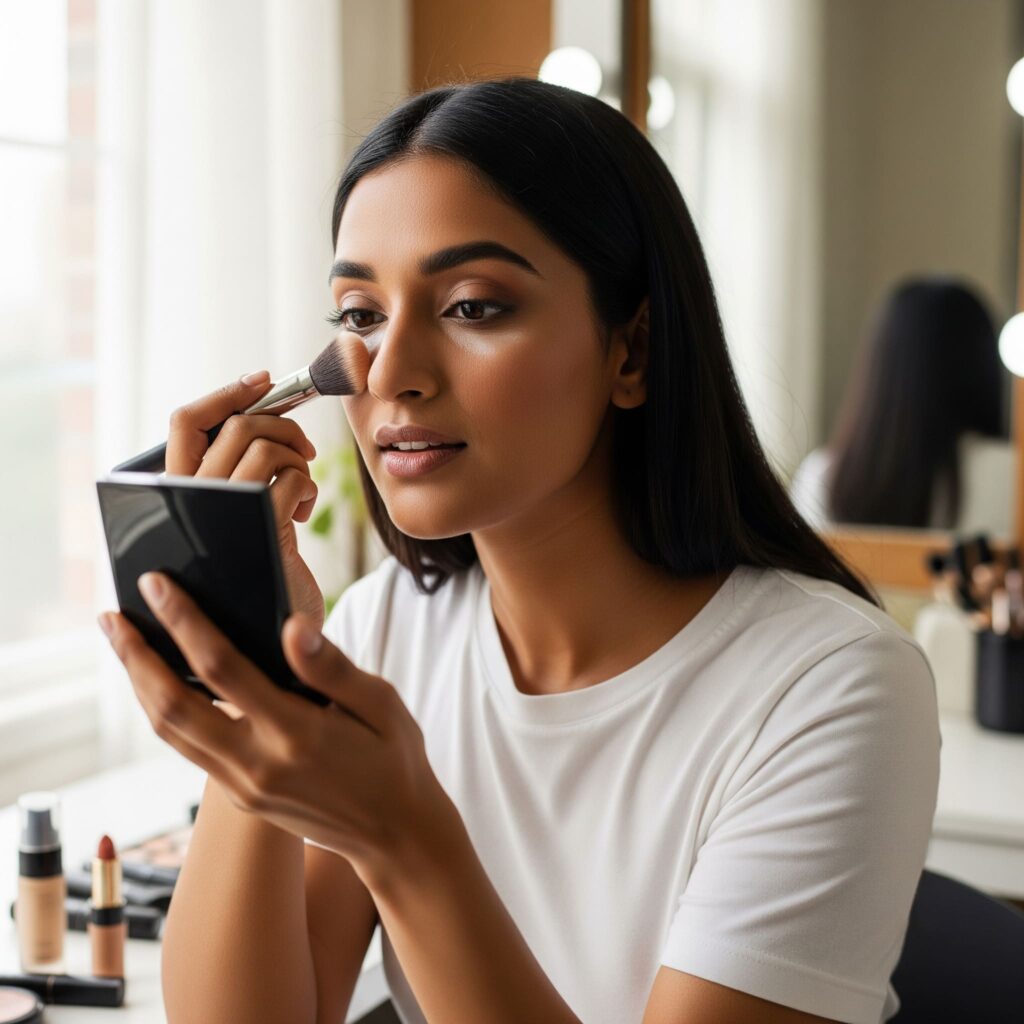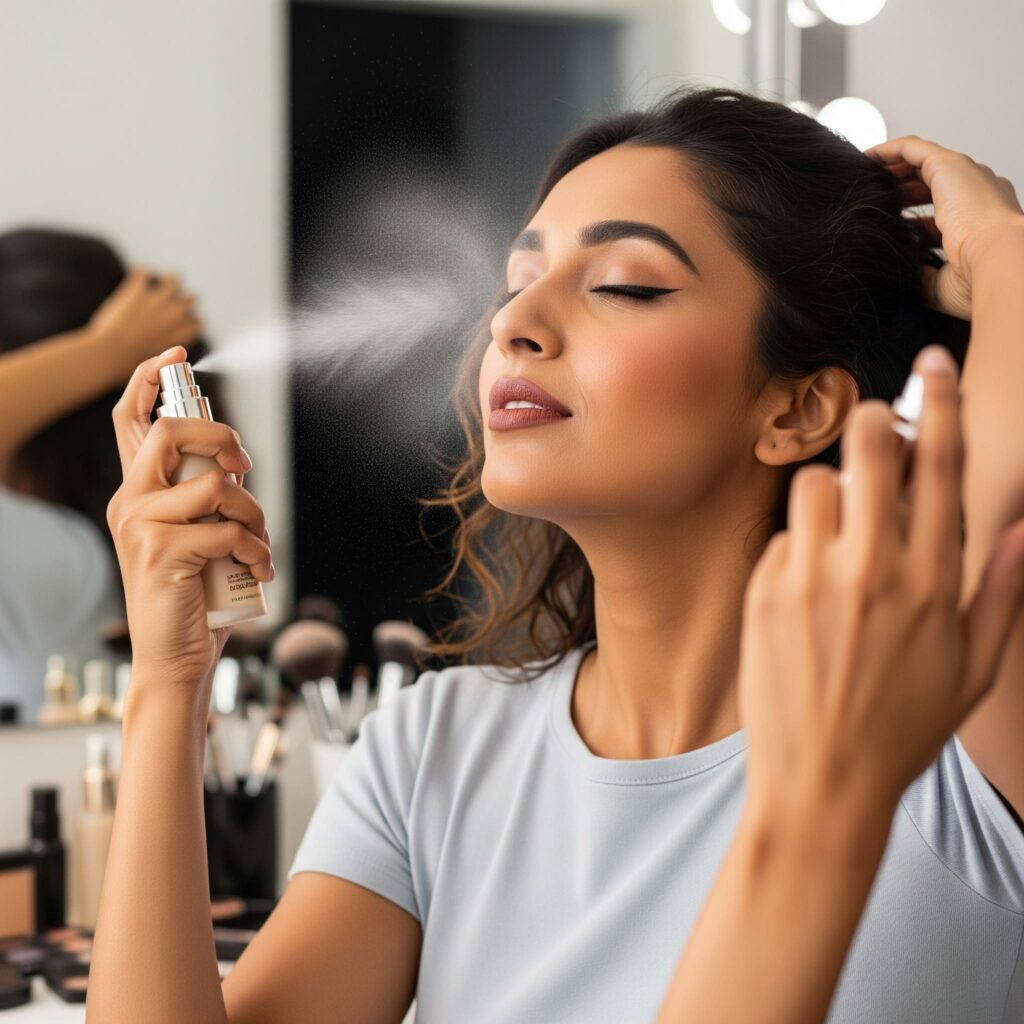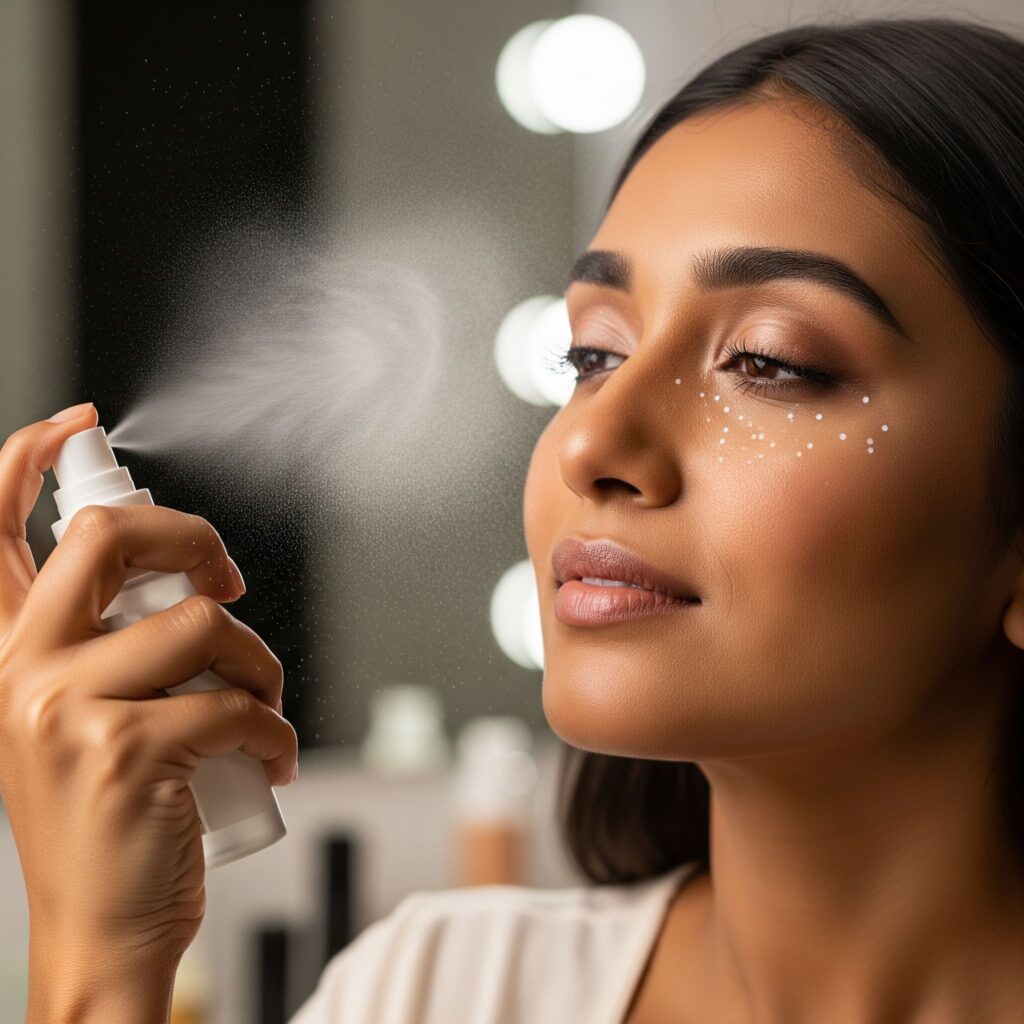Choose between setting powder and setting spray based on your skin type and desired makeup finish. Setting powder is ideal for oily skin to control shine, provide a blurred, filtered look, and set makeup products. Setting spray is suitable for all skin types and acts as a topcoat to blend makeup, increase wear time, and prevent fading or transferring. You can also use both together for maximum longevity and a seamless finish.
Makeup lovers often wonder about the best way to lock in a fresh look, which is why the debate of setting powder vs setting spray is so popular. Setting powder vs setting spray both help finish your makeup, but they serve different purposes based on skin type and desired effect. Whether you choose setting powder vs setting spray for oily skin or dry skin, understanding their benefits is key. This guide on setting powder vs setting spray will help you master makeup longevity and achieve your perfect finish.
Table of Contents
What is Setting Powder?
Setting powder is a finely milled powder product used to set foundation and concealer in place, absorb excess oil, and reduce shine. It provides a matte or semi-matte finish and helps makeup stay put by minimizing creasing and smudging. When choosing between Setting Powder vs Setting Spray, it’s important to understand that setting powder offers a matte finish and oil control, while setting spray provides a hydrating or dewy finish and seals makeup after application. Many makeup enthusiasts use a combination of Setting Powder vs Setting Spray to achieve long-lasting, flawless makeup. Ultimately, the choice between Setting Powder vs Setting Spray depends on your skin type and the finish you desire.

Types of Setting Powder
When considering makeup finishes, understanding Setting Powder vs Setting Spray is key. Setting Powder vs Setting Spray each offers unique benefits depending on your skin type and desired look. Setting Powder vs Setting Spray helps lock your foundation for longer wear, but their textures and application methods differ. Choosing between them or combining both can give you flawless, long-lasting makeup.
- Loose setting powder: Offers lightweight coverage and oil control; ideal for normal to oily skin.
- Pressed setting powder: Portable and convenient; good for touch-ups throughout the day.
- Translucent powder: Colorless, suitable for all skin tones; controls shine without adding color.
- Tinted powder: Adds additional coverage or color correction while setting makeup.
Benefits of Setting Powder
When choosing between Setting Powder vs Setting Spray, it’s important to understand their unique benefits. Setting Powder vs Setting Spray helps you decide based on your skin type and the finish you desire. While setting powder offers a matte, oil-absorbing effect, setting spray provides hydration and a dewy glow. Knowing the difference in Setting Powder vs Setting Spray will help you achieve the perfect makeup look that lasts all day.
- Absorbs excess oil to reduce shine, perfect for oily skin.
- Sets liquid or cream makeup for longer wear and minimal smudging.
- Smooths skin texture and blurs fine lines or pores.
- Provides a matte finish for a polished look.
- Lightweight and buildable for natural to full coverage effects.

How To Use Setting Powder
When choosing between setting powder vs setting spray, it’s important to know how each works. Setting powder vs setting spray offer different finishes-powder gives a matte look, while spray provides a dewy glow. Understanding the benefits of setting powder vs setting spray can help you decide which suits your skin type and makeup style best. Both products help lock in makeup, but knowing when to use setting powder vs setting spray is key for flawless, long-lasting results.
- After applying foundation and concealer, gently press or dust the powder on your face using a fluffy brush or beauty sponge.
- Focus on oily areas like the T-zone (forehead, nose, chin).
- Use a light hand to avoid cakey texture.
- For touch-ups, use pressed powder throughout the day to control shine.
- Avoid over-applying on dry or textured areas to prevent emphasizing flakes.
Learn the key differences between face scrub and face wash in this blog.
What is Setting Spray?
Setting spray is an essential part of many makeup routines, designed to lock your makeup in place and extend its wear throughout the day. When considering setting powder vs setting spray, it’s important to understand that setting spray is applied as a final liquid mist, while setting powder is usually a dry powder used earlier in the makeup process to reduce shine and set foundation.
The main difference in setting powder vs setting spray lies in their texture and finish-powders typically offer a matte finish, while sprays can provide a range from dewy to matte, depending on the formula. Choosing between setting powder vs setting spray depends on your skin type and desired makeup look, but many experts recommend using both for long-lasting, flawless makeup.

Types of Setting Spray
When choosing makeup products, understanding the difference between Setting Powder vs Setting Spray is essential. Setting Powder vs Setting Spray serve similar purposes but have unique benefits depending on your skin type and desired finish. Whether you prefer a matte look with Setting Powder vs Setting Spray’s ability to hydrate and lock in your makeup for longer, both have their place in your beauty routine.
- Mattifying sprays: Control oil and provide a shine-free finish, ideal for oily skin.
- Hydrating sprays: Add moisture and a radiant glow for dry or dull skin.
- Long-lasting sprays: Designed to hold makeup intact for hours, suitable for special occasions.
- Refreshing sprays: Provide a light mist for midday makeup boosts.
Benefits of Setting Spray
When choosing between Setting Powder vs Setting Spray, understanding their benefits can help you decide which suits your skin best. Setting Powder vs Setting Spray each offer unique advantages-powder mattifies oily skin while spray hydrates and sets makeup for a natural finish. Many makeup enthusiasts find that using Setting Powder vs Setting Spray together provides long-lasting wear and a flawless complexion.
- Prolongs makeup wear and prevents fading or smudging.
- Provides a fresh, natural finish, minimizing powdery appearance.
- Hydrates skin and reduces dryness caused by powders.
- Lightweight and easy to apply, suitable for all skin types.
- Creates a seamless appearance by blending makeup layers.
How To Use Setting Spray
When deciding between Setting Powder vs Setting Spray, it’s important to know how each product works. For a flawless finish, many prefer using both Setting Powder vs Setting Spray together to lock in makeup and control shine. Understanding Setting Powder vs Setting Spray can help you choose the best option for your skin type and ensure long-lasting wear.
- Complete your makeup application.
- Hold the bottle about 8-10 inches from your face.
- Spray evenly in an “X” and “T” shape to cover all areas.
- Let it dry naturally or gently pat with fingers.
- Reapply lightly during the day as needed, especially for oily skin.
Discover the key differences between waxing vs shaving for smooth, lasting results.

Setting Powder vs Setting Spray: What’s The Difference?
Setting Powder vs Setting Spray are both essential in makeup routines but serve different purposes. When choosing between Setting Powder vs Setting Spray, consider your skin type and the finish you desire. Understanding the key differences in Setting Powder vs Setting Spray can help you achieve a flawless, long-lasting look.
| Feature | Setting Powder | Setting Spray |
| Texture | Fine powder to absorb oil and set makeup | Liquid mist to lock makeup and refresh skin |
| Finish | Matte or semi-matte | Matte, dewy, or natural depending on formula |
| Effectiveness | Controls shine, reduces oil, minimizes pores | Blends makeup and enhances longevity |
| Skin Types Suitability | Ideal for oily and combination skin | Suitable for all, varies by product type |
| Application | Applied with brush or puff | Sprayed evenly over face |
| Portability | Compact press powder good for touch-ups | Handheld mist easily applied any time |
Discover key differences between pedicure and manicure for perfect nail care.
How To Choose Between Setting Powder and Setting Spray
When deciding how to set your makeup, understanding the differences between setting powder and setting spray is key. Setting Powder vs Setting Spray both help lock your makeup in place, but setting powder is great for reducing shine and providing a matte finish, while setting spray offers a dewy, natural look. Choosing between setting powder vs setting spray depends on your skin type and the finish you desire. Your choice depends on your specific skin needs and preferences:
- For oily skin, consider setting powder for oily skin to combat shine and control oil production. Complement with setting spray for oily skin if you want additional makeup.
- For dry skin, setting spray for dry skin helps add hydration and keep the skin glowing, avoiding a cakey look that powders may cause. In some cases, a light application of finely milled setting powder for dry skin can help absorb minimal oil.
- If you prefer a matte finish and longer control, powders excel. However, if you’re aiming for a natural glow and hydration with makeup fusion, sprays are beneficial.
- Sometimes combining both-powder for initial setting and spray for blending and finishing-yields the best results.
Discover the key differences between waxing and laser hair removal for smooth, lasting results.
Final Insights: Setting Powder vs Setting Spray
Both Setting Powder vs Setting Spray play essential but complementary roles in a flawless makeup routine. When deciding between Setting Powder vs Setting Spray, it’s important to know that powders provide immediate oil control and a matte finish, ideal for oily or combination skin types. On the other hand, Setting Powder vs Setting Spray also includes setting sprays, which hydrate, set, and refresh the makeup while maintaining a natural finish suitable for all skin types.
Understanding your skin type and makeup goals guides the selection of matte or dewy finishes and choosing the appropriate product, whether you prefer setting powder or setting spray. Choosing the right product ensures your makeup stays flawless, fresh, and comfortable all day long. Discover the key differences between hair cleanser and shampoo in this blog.
Conclusion
In the debate of Setting Powder vs Setting Spray, both have unique benefits to perfect your makeup. Setting Powder vs Setting Spray helps control shine and lock your look in place. Choosing between Setting Powder vs Setting Spray depends on your skin type and finish preference. Mastering the use of Setting Powder vs Setting Spray will elevate your makeup routine and boost your confidence.
For personalized makeup services tailored to all skin types and occasions, visit Peacock Salon in Vashi, Navi Mumbai. Our skilled artists specialize in enhancing natural beauty with expert techniques for bridal, party, and everyday looks. Find us at Mahavir Center, Shop No. 20, 21, 21A, 22, next to Golden Punjab Hotel, Sector 17, Vashi or call +91 9324774567 to book your consultation and transform your look with flawless makeup artistry.
Setting Powder vs Setting Spray – FAQs
What is the difference between setting spray and setting powder?
Setting powder absorbs oil and mattifies, while setting spray locks makeup and adds hydration or matte finish depending on the formula.
Which is better, setting spray or setting powder?
Both serve different purposes; powder controls oil and mattifies, spray locks makeup and hydrates. Choice depends on skin type and finish preference.
What setting spray is best for oily skin?
A mattifying setting spray with oil-controlling ingredients helps reduce shine and prolong makeup wear for oily skin.
Can setting powder be used on dry skin?
Yes, but choose finely milled, hydrating powders to avoid emphasizing dryness.
What are the benefits of setting spray?
Setting sprays prolong makeup wear, reduce powdery look, hydrate skin, and blend makeup seamlessly.
How do I use setting powder correctly?
Apply with a fluffy brush after foundation and concealer, focusing on oily areas to reduce shine.
Does setting spray work better than powder?
Setting sprays hydrate and lock makeup but may not control oil as effectively as powders; a combination is often best.
Can I use both setting powder and spray in a routine?
Yes, using powder to set makeup first, then spray to blend and refresh improves longevity and finish.
Are setting powders suitable for acne-prone skin?
Choose non-comedogenic, oil-free powders formulated for acne-prone skin to prevent breakouts.
How often should I reapply setting spray?
Reapply as needed, typically every 4-6 hours or when makeup starts to fade or feel dry.
